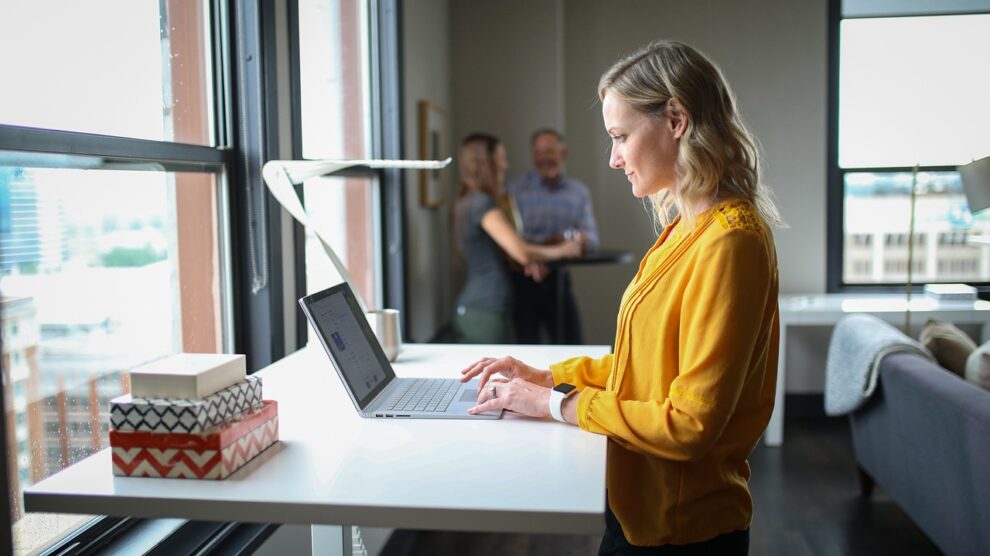Are you mostly spending at least 6-7 hours sitting each day at your office?
Then, chances are you likely reading this blog while hunched at your chair.
It is time to find out how standing desks could counteract your sitting time and provide other health benefits that could improve your wellbeing.
Sitting is as harmful as smoking a cigarette
People spend on average 5 hours 41 minutes sitting each day – commuting in a car or on public transport, working at the office or binge-watching Netflix.
Sitting has become our default posture nowadays. But our body is not designed to be such. We have to relook at how to negate sitting effects.
Standing desks are becoming an increasingly popular way to create movement, without disrupting your workflow.
Top 5 health benefits of standing desks at your workplace
1. A standing desk could reduce your risk of musculoskeletal problems
Back or neck pain is commonly experienced by office workers. They are closely associated with long hours at a desk job.
This is where an ergonomically designed electric standing desk converter comes in handy.
In a comparative study on a group of workers in Australia, researchers compared the fatigue levels of those who used a stand-up desk converter every 30 minutes versus those who were seated only.
They found a significant reduction of 31.8 percent in lower back pain and a 22% reduction in overall tiredness in those who used a sit-stand desk.
If you experience neck or back pain, consult with your doctor or physiotherapist to see whether a standing desk can help you relieve your musculoskeletal problems.
2. Standing lowers the risk of heart disease
In the 1950s, British researchers compared the rate of heart disease among bus drivers and bus conductors in London.
In their findings, 42 percent more bus drivers experienced heart attacks compared to bus conductors.
The difference in their work? Bus drivers sit the whole day while bus conductors work mostly on their feet.
Another study conducted on 1,00,000 adults in the American Journal of Epidemiology showed that people who sat for 6 hours or more died earlier than those who sat for 3 hours or less.
This was attributed mostly to cardiovascular disease in the participants who were more sedentary.
3. Standing decreases your risk of developing Type 2 diabetes
Using a standing desk could lower your blood sugar levels.
According to a study published in Diabetologia, people with a sedentary lifestyle have higher chances of developing type 2 diabetes.
It was associated with a 22 percent increase in the risk of type 2 diabetes, and a 39 percent increased risk of metabolic syndrome.
The silver lining?
Just breaking up your prolonged sitting with frequent and quick walking breaks could significantly counteract the harmful effects of this sedentary lifestyle disease.
And with the use of a standing desk, it is even much easier to achieve this.
So if you are pre-diabetic or have a family history of the disease, investing in a standing desk could be something worth considering when it comes to helping you be more active.
4. Standing may reduce your risk of cancer
Some studies have found a higher risk of certain types of cancer for inactive people.
A survey conducted in 2011 by the American Institute of Cancer Research found that extended hours of sitting is responsible for 49,000 cases of breast cancer and 43,000 of colon cancer in the U.S. annually.
While the underlying reason for this correlation is unclear, the scientists found a higher number of C-reactive proteins (a type of biomarker) in people who sit for longer durations. This is a factor in the development of cancer.
As Dr. Neville Owen of the Baker IDI Heart and Diabetes Institute puts it-
“Sitting time is emerging as a strong candidate for being a cancer risk factor in its own right. It seems highly likely that the longer you sit, the higher your risk. This phenomenon is not dependent on body weight or how much exercise people do.”
5. Standing linked to a reduced risk of obesity
Fidgeting, shaking your foot and an inability to sit still could make you leaner and healthier. But how?
Dr. James A Levine of the Mayo Clinic recruited a group of workers who engaged in routine exercise while following a specific diet.
He found that despite the standardized diet and exercise, some participants gained weight, and others did not.
Dr. Levine’s study found that obese people tend to fidget much less as compared to leaner people. In fact, obese people spend at least 2 hours more each day sitting idle, compared to their leaner counterparts.
A fact that might astonish you is that fidgeting alone is enough to burn 350 extra calories per day, which adds up to an awe-inspiring weight loss of 4 to 13 kg per year!
One of the benefits of standing desks is that it encourages movement without interrupting your work.
When you stand, you are naturally more likely to fidget or to move around your office. Try it and you’ll see it!
So what solution do we have for office workers whose jobs require them to sit so much?
One thing is clear – less sitting and more moving overall contribute to better health.
From standing up in meetings, to stepping away to speak to your colleagues, or using the stairs instead of the elevator could increase your movements and thus boost your health.
However, to make the activity at work a regular habit, we recommend that you look into using a standing desk or standing desk converter like Altizen.
They are the easiest way to achieve the health benefits or more activity, without affecting your work





